- Geopolitics
- Non State Actors
- Organised crime
- Intelligence School


Russian-Taliban Dynamics: Bridging Security and Diplomacy
The rise of monero in terrorist financing, italian intelligence community: a deep dive, turkish intelligence operations: a 6-month forecast, timber smuggling and border security in east africa, fuerzas especiales (fes): mexican navy’s special mission unit, big safari: the us air force’s marriage with private acquisition.
1.0 Introduction:
In the world of military aviation, innovation and adaptability are essential to maintaining an edge over potential adversaries. The United States Air Force (USAF) has consistently pushed the boundaries of technology, and one program that has played a pivotal role in achieving this is the Big Safari program.
Founded in 1952, Big Safari has been at the forefront of the rapid acquisition and modification of aircraft, enabling the US Air Force to respond quickly to emerging threats and operational requirements. The purpose of Big Safari was to marry talent and technology from private industry with the US Air Force’s evolving portfolio of requirements during the Cold War.
Big Safari was very much a product of the contest between East and West. It gave birth to aircraft which are fascinating in their own right and have become household names. In this article, we will explore the success, development and controversies surrounding Big Safari.
2.0 Mottos, Symbols and Patches:
The following is a cursory overview of the mottos, symbols and patches associated with Big Safari. There are two variations of patches associated with Big Safari, one blue and one tan. The tan one is illustrated below.
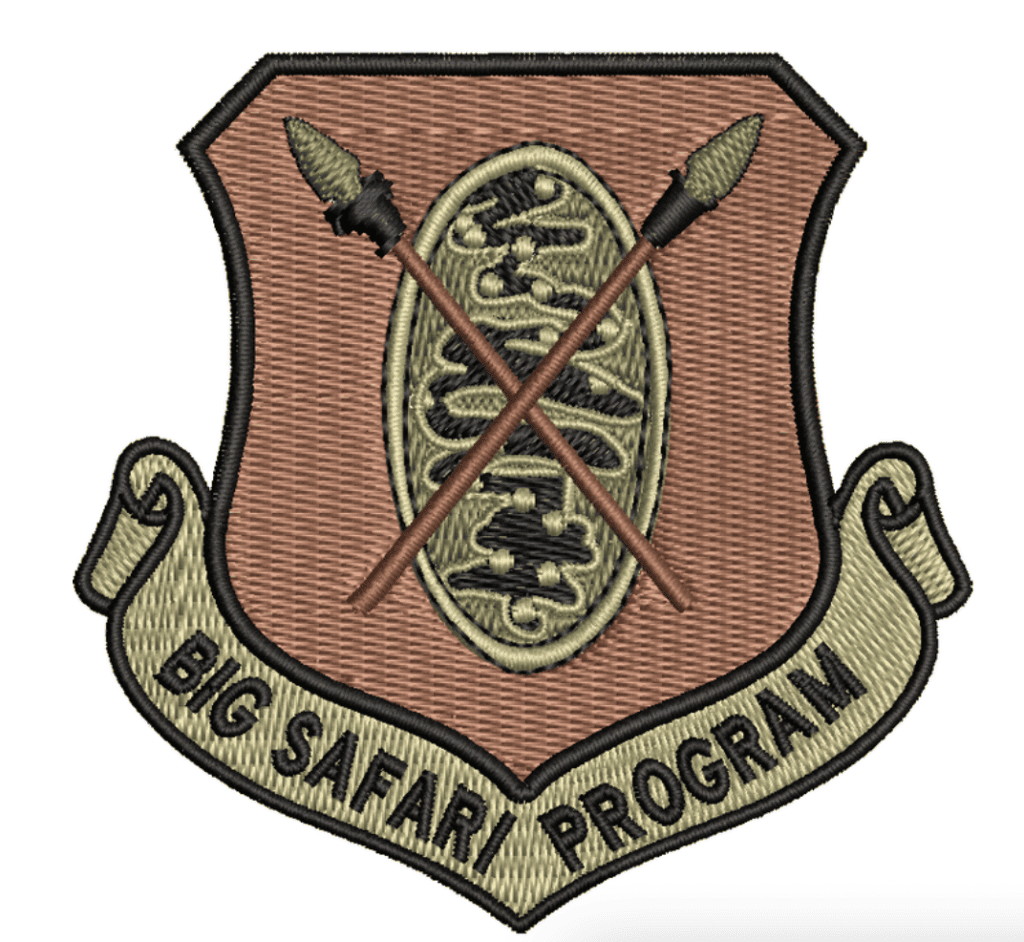
There is no official motto printed on the Big Safari patch. Overall, there is no official motto associated with Big Safari. After the program was reactivated in 2006 as the 645th Aeronautical Systems Group, the US Air Force still did not award the program a motto. The emblem was officially approved by the Pentagon in 2021 [ source ]. On top of this, there is no official explanation of the symbolism of the patch.
3.0 History:
In 1952, the United States found itself in an increasingly crowded threat environment. Although the fight against fascism led the United States into a brief partnership with the Soviet Union, the spirit of amicability dissipated rapidly. Soon, the USSR imposed an Iron Curtain across the breadth of Europe and the Korean Peninsula turned into a shooting gallery. The nucleus of what eventually became Big Safari began with USAF Brig. General Walter Wise [source]. General Lauris Norstad, then the commander of US Air Forces in Europe, found himself in need of an aircraft which didn’t exist. In order to peer across the Iron Curtain, General Norstad needed a totally new reconnaissance aircraft capable of performing intelligence-gathering capabilities. In order to quickly develop this new aircraft, Air Force Chief of Staff Hoyt Vandenberg convened a series of meetings with high-level Air Force officers to develop a system which would allow the Air Force to procure the needed systems to rapidly give birth to special projects. To quote one of the Air Force generals involved in the inception of the Big Safari program, George Rhodes:
“There wasn’t anything common with what we were doing. We sat down and said OK: if we are going to do this, the first thing we have to do is to have procurement procedures that permit us to designate the contractor”.
The need to quickly procure contractors for special projects was at the heart of Big Safari’s purpose from the very beginning. The effort was initially envisioned as a 5-year program [source]. Rhodes established 8 separate guidelines which would govern the procurement of contracts and acquisition of new technology. Two of these guidelines stand out above the others. The first was that was not to be any set limit to budgets. The second was that every special project would be closed off to general personnel of the USAF [ source ]. In early 1952, responsibility for carrying out these tasks fell to the Air Material Command, under which Big Safari was initially organized.
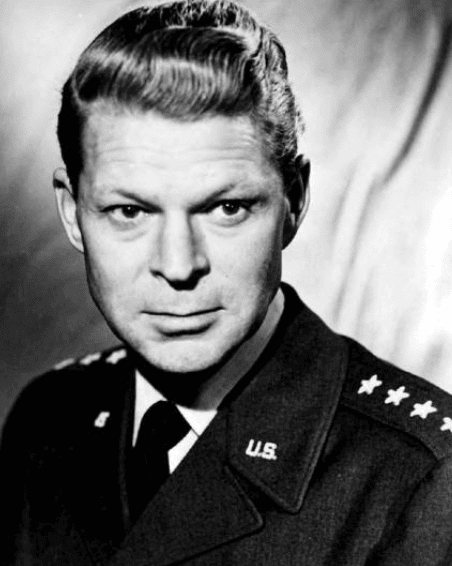
3.1 Later History and Reorganization:
The program was reorganized in 2004 and officially activated as a part of the 645th Aeronautical Systems Group in 2006 [ source ]. During its history, Big Safari went on to create the Rivet Joint program of reconnaissance aircraft and support ELINT, MASINT, IMINT and GEOINT intelligence collection efforts throughout the Cold War [source]. A major early contracting partner with the Big Safari program was Convair. Per Rhodes’ guidelines, all development took place at the Convair plant in Fort Worth from 1952 to 1961 [source]. Throughout the duration of these efforts, US Air Force personnel were absent from production efforts. Big Safari is probably the best example of private industry and military necessity for this reason. The Pentagon appears to have fully delegated the task of developing mission-critical aircraft. In this sense, it could very well be described as the origin of what President Eisenhower contemporaneously called the military-industrial complex.
4.0 Organization:
The Big Safari program was initially placed under the direction of the Air Material Command. The AMC was a major command of the newly formed USAF which handles the procurement, logistics and technical requirements of USAF aircraft. During the Kennedy Administration, the Department of Defense underwent a reorganization through a process similar to the Base Realignment and Closure (BRAC) system [ source ]. The AMC was split into the Air Force Logistics Command and the Air Force Systems Command. Big Safari worked closely onwards with Systems Command [ source ].
In 1992, these 2 commands were once again recombined into the AMC. Big Safari was eventually reactivated in 2005 after a hiatus of unknown length, though it is likely that the program was inactive from the late 1970s till the late 1980s [source]. It was in 2005 that Big Safari explicitly became the 645th Aeronautical Systems Group. The 645th is subordinated under the 303rd Aeronautical Systems Wing. Reportedly, the National Air and Space Intelligence Center provides a certain degree of input into the decision-making process at Big Safari [ source ].
5.0 Notable Aircraft:
There are literally hundreds of aircraft which were developed by Big Safari or received some degree of input from the program. They are too numerous to list in exhaustive form here. Rather, we will focus on a select number illustrating the program’s driving mantra. The program almost exclusively focused on reconnaissance and surveillance aircraft.
5.1 PIE FACE:
PIE FACE was the very first aircraft which fell under the Big Safari umbrella. The Air Force initially partnered with General Dynamics – Convair in order to streamline the procurement of aircraft for special ISR missions, and PIE FACE was the first dry run of this effort. What General Norstad realized in early 1951 was that the USAF’s ISR platforms were not well equipped to image East German and Soviet military formations and equipment moving into Berlin. While we do not know the specific limitations of the Air Force’s previous imaging equipment, given the nature of what was developed in PIE FACE, we can surmise that image resolution was far too poor for the purpose. The Air Force tasked an engineering team at Harvard University to develop a monster of a camera.
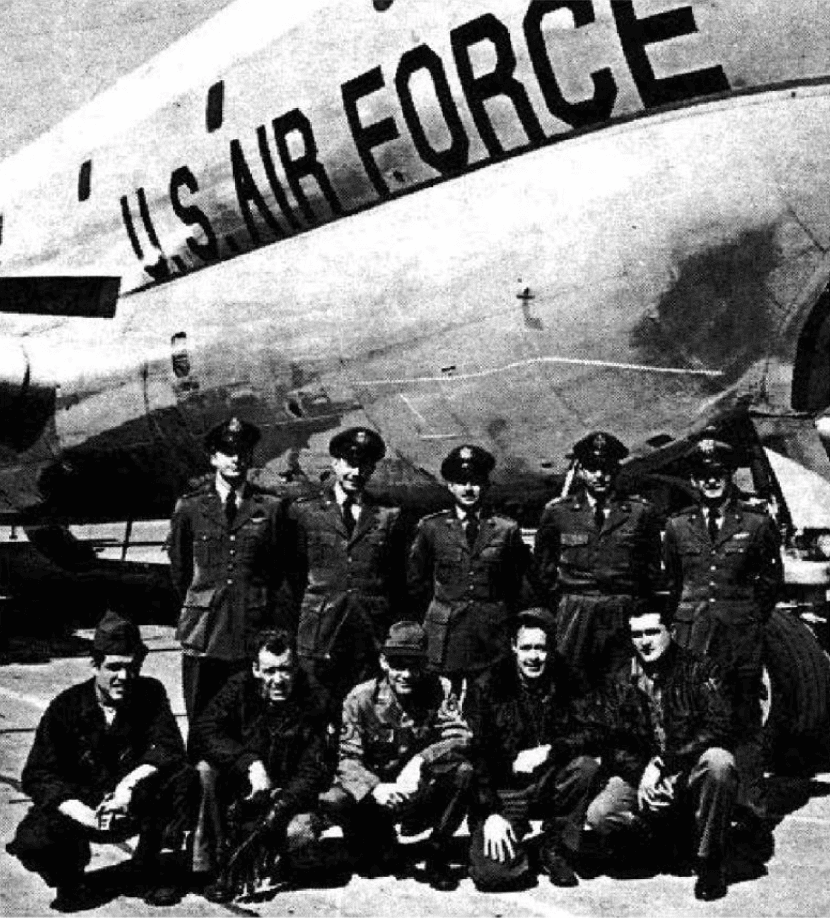
The team at Harvard developed a 20-foot-long camera lens, equipped with a pair of reflective mirrors and a huge F-8 lens. At the time, this was the largest camera installed in an aircraft [ source ]. A camera of that size would need a comparable airframe. The 2 units, known as Bertha and Betsy Mae, would come to use the largest roll of film ever ordered from Kodiak in the entire history of that company [ source ]. The only aircraft which was suitable at the time to host this immense array of optical equipment was the KC-97A. The aircraft was upgraded with structural modifications that could support the enormity of the camera. The PIE FACE aircraft was also equipped with 3 K-17 optical instruments [ source ]. PIE FACE went on to fly multiple ISR missions along the Berlin Air Corridor.
5.1 SARA JANE :
In 1954, Soviet premier Khrushchev visited the United States in an effort to thaw growing tensions and East-West rivalry [ source ]. American intelligence officials were reportedly convinced that Khrushchev’s Tu-114 was being used to photograph American military installations as it flew in [ source ]. Even if it was or was not true, it gave birth to the concept of SARA JANE. The idea was to convert C-54E VIP transport aircraft into ISR platforms that could fly over enemy installations in plain sight and under the guise of a diplomatic mission.
The entire project was obscured in an extra level of secrecy at Convair’s facility in Texas [ source ]. In total, 14 P2 cameras were fastened into the wings of the aircraft in fuel-tight pockets. These P2 cameras were complimented by a suite of additional lenses manufactured by Fairchild. Rather ingeniously, engineers added a mechanism that would dump fuel if the panels covering the cameras were removed. The design was designed to be totally covert, so much so that if if anyone ran an X-Ray over the wing, the mechanism would be hidden. The pilot was able to trigger pneumatic doors which covered the lenses from the cockpit, allowing the flight crew to activate the ISR suite at their discretion [ source ].
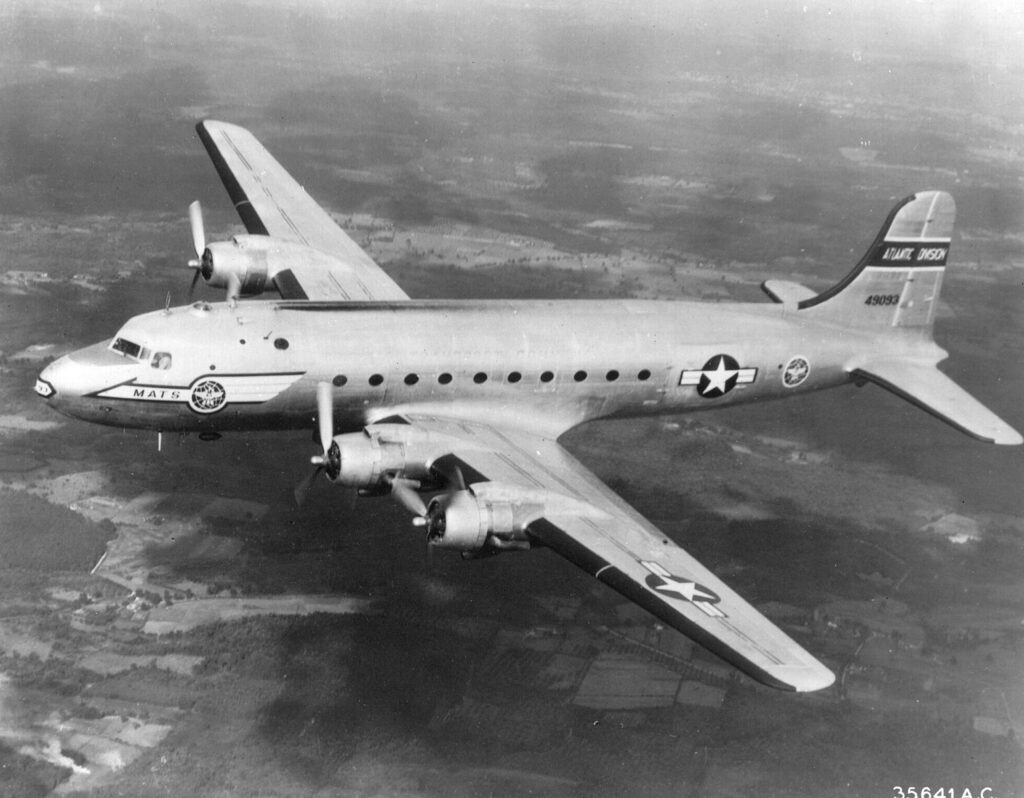
The two SARA JANE aircraft were stationed across West Germany and were probably utilized as Embassy support aircraft. One aircraft was used to fly supplies to the US Embassy in Moscow. According to retired USAF Colonel Dan Gareri, a Soviet officer accompanied the crew on this flight. By use of a covert inter-phone panel installed in the crew cabin, US personnel were able to secretly trigger the ISR suite without the knowledge of the Soviet minder [ source ].
5.2 NANCY RAE :
Beginning in the early 1960’s the need for large, heavy strategic bombers to deliver nuclear payloads over Soviet or American cities was beginning to wane. This was due in part to the addition of two new arms of the nuclear triad, submarine-launched ballistic missiles (SLBMs) and intercontinental ballistic missiles (ICBMs). Commensurate with that shift, however, was the growing need to monitor Soviet ICBM tests with highly advanced sensors aboard intelligence aircraft. NANCY RAE was an early attempt to fill this intelligence gap. The aircraft initially was an unmodified KC-135 which underwent extensive upgrades at the Big Safari facility in Texas [ source ].
The sensors aboard NANCY RAE can be broadly classified into 2 different varieties, optical sensors and ELINT sensors. These sensors would measure not only the trajectory and irradiance of the ICBM’s reentry but also ground communication from Soviet naval assets or ground forces. According to one crew member on NANCY RAE, the crew practically lived on the aircraft while it was deployed in Dakar, Senegal [ source ]. Col. Bill Grimes, a major figure in the Big Safari saga, was deployed on NANCY RAE during it’s later flights.
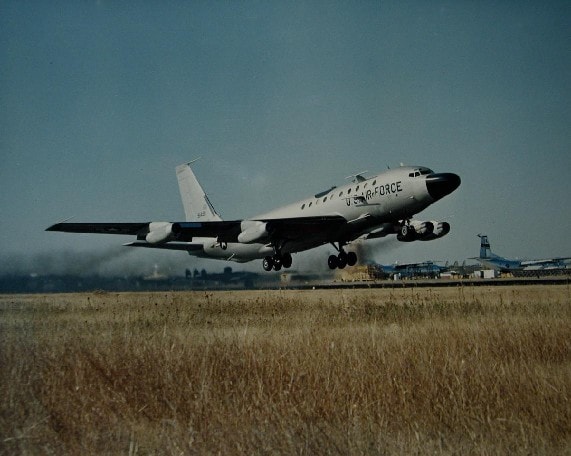
NANCY RAE had a prolific career. It’s 40-strong crew gained the title “Ali Baba and the 40 Thieves”. This name reflected the uncanny ability of NANCY RAE to grab sensitive Soviet communications. The aircraft’s mission profile was so successful that President Kennedy was given weekly briefings on the data gathered by the aircraft [ source ].
5.3 SPEED LIGHT BRAVO:
SPEED LIGHT BRAVO provides an excellent glimpse into exactly why the Big Safari program existed in the first place. On 9 August 1964, Soviet Premier Nikita Khrushchev issued an alarming proclamation. He asserted that the USSR was fully capable of building and detonating a 100-megaton nuclear bomb. This was a shocking amount of destructive firepower. In order to prove his claim, he announced that the USSR would conduct a test of a warhead at a 50-megaton yield. Reportedly, this announcement caught the immediate attention of researchers at the Los Alamos Laboratory in New Mexico [ source ].
The team at Los Alamos had a sensor array capable of monitoring the gigantic explosion, but no suitable aircraft to carry it close to the detonation site. A request was put in with Fort Worth and Big Safari to load this sensor array onto a JKC-135A. This particular aircraft had been outfitted with lead lining in limited areas, making it suitable to monitor the single largest explosion in human history [ source ].
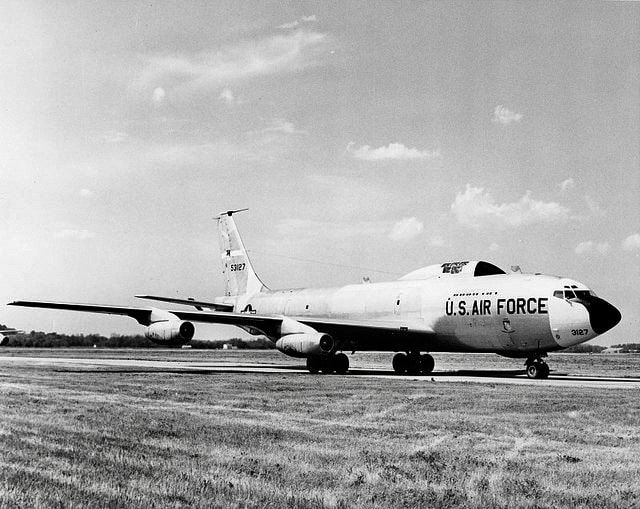
Between 22 and 27 October, 1964, SPEED LIGHT BRAVO was received and outfitted with the relevant sensors, a mere 5 days [ source ]. This is probably the best example which highlights the purpose of the Big Safari program. A team of researchers identified a need. The military stepped into the connect their technology with a private contractor, in this case Convair, and the contractor delivered a finished product in less than a week. Reportedly, the Air Force was told to push the project through and deal with the paper work later [ source ].
On 30 October, a Soviet Tu-95 bomber dropped a nuclear payload over Sukhoy Nos on Severny Island. This payload was dubbed BIG IVAN, but it is better known as the Tsar Bomba. The device was intentionally blunted so that it would only detonate at 50 megatons. The detonation was so massive that the nuclear blast created a shockwave the repelled against the earth, such that the fireball never actually reached the ground [ source ]. SPEED LIGHT BRAVO was damaged by the sheer heat of the event and totally irradiated, although the crew appeared to be unaffected by the extreme radiation [ source ]. Nevertheless, the aircraft was eventually scrapped after it was deemed un-airworthy. SPEED LIGHT BRAVO unintentionally flew far to close to the blast zone [ source ].

5.4 PEE WEE 1-3:
The PEE WEE program stands out amongst other Big Safari endeavors due to the close cooperation of the Pakistani Air Force in it’s implementation. Originally a set of B-57 Canberra bombers, these aircraft played a vital role in surveillance of Soviet missile launches out of Kaputsin Yar. The US Navy had a poor track record of honoring commitments made to Pakistan and India, repeatedly crossing over into restricted airspaces of either country. Accordingly, Islamabad told the US Navy it was no longer welcome in Peshawar [ source ].
After a series of discussions with the Pakistani’s, the United States ultimately came into a comprised arrangement. Pakistan would allow for the resumption of intelligence gathering air operations with aircraft piloted by Pakistani officers. Moreover, the Pakistani’s would be responsible for the upkeep of the aircraft [ source ]. The bomb bay of the aircraft was fitted out with a sensor capable of receiving missile telemetry and the nose cone was elongated to accommodate a dual set of phased array S-band antennae [ source ]. Sensors were installed for radiation detection [ source ]. PEE WEE I and PEE WEE II were operational for little more than a year until the introduction of PEE WEE III.
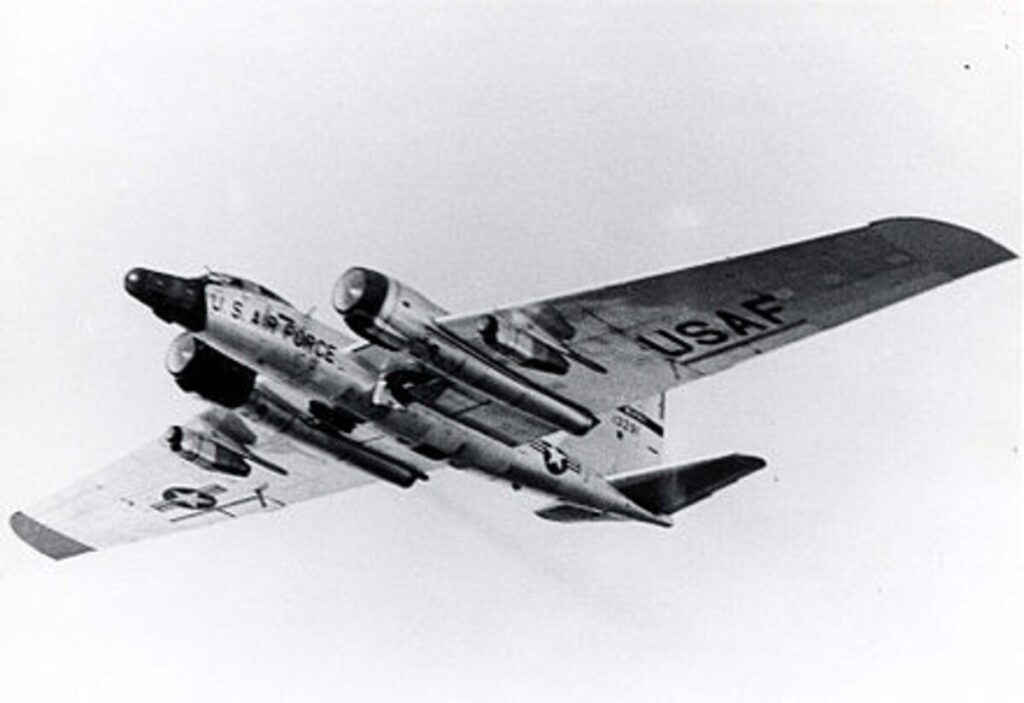
When the USSR shot down Gary Powers and his U-2 spy plane in 1960, President Eisenhower instituted a moratorium on high-altitude reconnaissance flights over the Soviet Union. PEE WEE III attempted to reinstate that mission profile. PEE WEE III was a complete redesign of the B-57’s airframe. The wingspan was doubled to an impressive 121 feet. Two additional engines were added, a set of Pratt and Whitney TF-33-P-11 Turbofan engines. These were far more powerful than the previous Wright J-65 Turbojets. To complement this increased power, two Pratt and Whitney air-started J60-P-9 turbojets were mounted under each wing and could be detached from the cockpit [source]. In addition to this, the cockpit was modified to fit two crew members wearing purpose-built pressurized suits to sustain the crew at high altitudes. A newer ejection seat system was also installed. Because of the high importance that this program entailed, Big Safari was given free rein to avoid cumbersome regulations and bureaucratic fancies to finish the aircraft on time [ source ].
Alongside Soviet missile tests, it is probable that PEE WEE aircraft were used to collect intelligence on Chinese nuclear activities as well. At least one PEE WEE III aircraft was significantly damaged during the 1965 Indo-Pakistani War [ source ].
5.5 RIVET DIGGER:
With the introduction of the Limited Test Ban Treaty in August of 1963, the global environment was given a respite from the deleterious effects of atmospheric nuclear testing. However, Cold War paranoias meant that the United States never fully trusted the Soviet Union to adhere to the terms of the treaty. The ‘Readiness Program’ was started in order to rapidly re-activate nuclear test monitoring aircraft if the Soviet Union decided to violate the terms of the treaty. The EARLY DAY/RIVET DIGGER aircraft were the answer to that need.
Three NC-135A aircraft were set aside for the project. Each was ‘sponsored’ by a different scientific organization. Overall, the KC-135 family of aircraft has undergone numerous modifications and adaptations to fulfil a wide range of specialized roles [source]. These variants have showcased the platform’s flexibility and longevity, allowing it to remain a vital asset in military operations, aerial refuelling, intelligence gathering, and experimental research. RIVET DIGGER probably stands out amongst all of the other variants due to its bizarre features. The aircraft was crewed by personnel from the Air Force Special Weapons Center but complemented by a scientific contingent from each of the sponsoring scientific bodies. Evidently, military personnel found it difficult to manage the larger-than-life egos of the science teams from Lawrence Livermore, Los Alamos and Sandia National Laboratories [ source ].
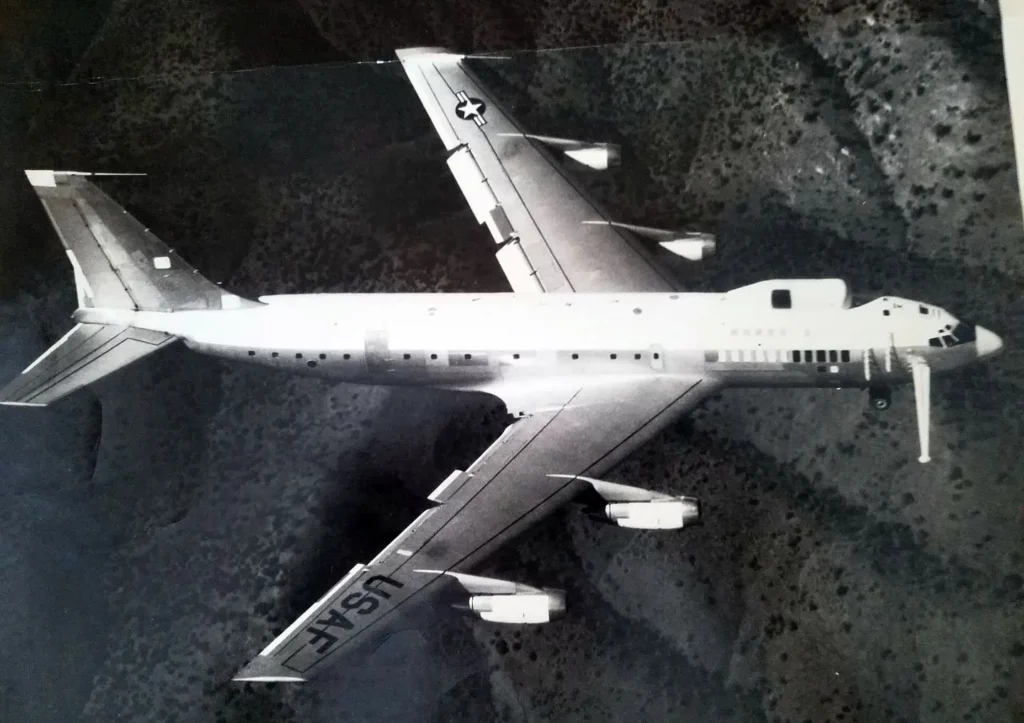
These aircraft were designed to conduct intelligence gathering on atmospheric nuclear tests, but when they were not used in that capacity, they were deployed for scientific data collection flights. These induced studying solar eclipses and cosmic rays [ source ].
6.0 Phoenix Ghost UAV
This April, the White House officially announced the existence of a new UAV during an announcement of a new aid package to the Ukrainian military. Among the various items, the US was sending 120 Phoenix Ghost suicide drones. Likely very similar to the Switchblade UAV, the Phoenix Ghost is reported to have a certain degree of ISR capabilities. The entire project was managed and sourced through Big Safari [ source ].
The Ukrainians have already begun intensive training with the platform and it’s possible that the system has already been deployed in the Donbas [ source ]. It is still too early to truly assess the impact of this new UAS, but the public will almost certainly be able to catch even a cursory glimpse of its performance in Ukraine given the shower of information and media which is posted online regularly.
7.0 Big Safari and L3 Harris:
Big Safari initially started out with a special relationship with General Dynamics – Convair. Over time, relationships have shifted. Currently, one of Big Safari’s major partners is L3 Harris. This relationship has not been without a degree of turbulence. The Inspector General of the Department of Defense has investigated L3 over the transfer of ISR platforms to the Kenyan government [ source ].
In 2017, L3 and Big Safari came under intense scrutiny from two GOP members of the House of Representatives. According to two USAF Majors, L3 was awarded a contract for the sale of aircraft to Yemen at an excess of $15 million more than the next competitor, IOMAX in 2014 [ source ]. In the case of the Pentagon’s Inspector General’s investigation, it was alleged that L3 was awarded a contract to manufacture border security aircraft for the Kenyan government despite having little to no experience in actually designing or manufacturing aircraft to the required specifications [ source ].
8.0 Other Controversies:
While the US Air Force’s Big Safari program has been lauded for its contributions to the rapid acquisition and modification of aircraft, there have been some controversies associated with the program. These controversies mainly revolve around issues such as cost overruns, lack of transparency, and concerns about accountability. Here are some of the controversies surrounding Big Safari:
Budgetary Concerns: One of the primary controversies surrounding Big Safari is the issue of cost overruns. Critics argue that the program has experienced significant budgetary challenges, with projects exceeding initial estimates and timelines. This has led to increased scrutiny of the program’s financial management and calls for improved cost-control measures. For example, a contract went to L3 over IOMAX, $15 million above IOMAX’s stated price [ source ].
Lack of Transparency: Some critics have raised concerns about the lack of transparency surrounding the Big Safari program. As it operates in a classified environment, there is limited public visibility into the program’s activities, decision-making processes, and project outcomes. This lack of transparency has led to questions about accountability and the potential for misuse of resources [ source ].
Contracting Practices: The contracting practices associated with Big Safari have also faced scrutiny. Critics argue that the program relies heavily on sole-source contracts, limiting competition and potentially resulting in higher costs. There have been calls for greater competition and increased oversight to ensure fairness and efficiency in the acquisition process [ source ].
Impact on Traditional Acquisition Programs: Another controversy arises from the perception that Big Safari’s rapid acquisition and modification capabilities may divert resources and attention from traditional acquisition programs. Some argue that the focus on quick solutions through Big Safari may hinder the development of long-term, sustainable systems and technologies [ source ].
Ethical Considerations: The nature of Big Safari’s operations, often involving sensitive technologies and classified information, raises ethical considerations. Critics question the program’s adherence to legal and ethical standards in areas such as privacy, data collection, and potential implications for international norms, agreements and the laws of war [ source ], [ source ].
Congressional Oversight: Controversies surrounding Big Safari have prompted increased congressional oversight. Lawmakers have called for more rigorous monitoring, accountability, and reporting on the program’s activities to ensure proper use of taxpayer funds and alignment with national defence priorities [ source ].
It is important to note that the controversies surrounding Big Safari should be viewed in the context of the program’s mission and the challenging nature of rapidly acquiring and modifying aircraft in a dynamic operational environment.
9.0 Conclusion:
The history of the US Air Force’s Big Safari program is one of continuous innovation, adaptation, and collaboration. From its early focus on electronic reconnaissance to its involvement in developing stealth aircraft and supporting special operations, Big Safari has consistently pushed the boundaries of airborne capabilities. By bridging the gap between traditional acquisition processes and operational needs, the program has played a pivotal role in ensuring the US Air Force remains at the forefront of airborne innovation and rapid acquisition capabilities. Very recently, the US Space Force announced the establishment of the ‘Space Safari’ program through the Space and Missile Systems Center Special Programs Directorate. Space Safari will play the exact same role as Big Safari for USSPACECOM [ source ].
These partnerships demonstrate the importance of collaboration between the US Air Force and industry leaders in driving innovation, leveraging expertise, and delivering cutting-edge capabilities for the Big Safari program. By combining the resources and knowledge of these partners, the USAF can rapidly respond to emerging operational requirements and maintain a technological edge in the ever-evolving landscape of military aviation.

Table of contents
Get the weekly email from Grey Dynamics that makes reading intel articles and reports actually enjoyable. Join our mailing list to stay in the loop for free!
Related contents
Grey Dynamics is an Intelligence firm based out of London with a network of analysts, researchers, and investigators worldwide.
- Privacy Policy
- Terms & Conditions
New Phoenix Ghost drone was ‘Big Safari’ project
By Jon Harper
May 6, 2022

The new Phoenix Ghost suicide drone that the U.S. is supplying to Ukraine was a project overseen by a secretive Air Force office known as Big Safari, the Pentagon’s top weapons buyer revealed Friday.
The Biden administration on April 21 publicly revealed the system’s existence when it announced that it planned to send more than 120 of them to Ukraine as part of a broader security assistance package.
The research-and-development effort for the weapon was overseen by the 645th Aeronautical Systems Group, also known as Big Safari, which works on special projects, Undersecretary of Defense for Acquisition and Sustainment William LaPlante told reporters at the Pentagon. The organization is based at Wright-Patterson Air Force Base, Ohio.
“If you know anything about that office, they do lots of really great, fast-type work. They were very active during Afghanistan and Iraq” wars, he said.
The Phoenix Ghost tactical unmanned aerial system was already being developed by the U.S. military and AEVEX Aerospace before the recent Russian invasion began on Feb. 24.
“The Air Force was working on this and, in discussions with the Ukrainians again about their requirements, we believed that this particular system would very nicely suit their needs, particularly in eastern Ukraine,” Pentagon Press Secretary John Kirby told reporters last month.
On Friday, Kirby told reporters that a cohort of about 20 Ukrainian soldiers is about to wrap up a week-long training course on how to use the system.
LaPlante said that in the future the Pentagon may use an indefinite-delivery/indefinite-quantity (IDIQ) contract mechanism that will make it easier to buy additional Phoenix Ghost systems.
IDIQ is “a contract that has a ceiling on it but that you can put individual task orders against it. The nice thing about that is if later on, you have a contract already set up … if you want to go back and buy more of something even more than we originally planned,” he said. “It’s pretty straightforward to do it. I’m pretty sure we will have that arrangement in that case.”
More Like This
Mpes gain momentum for sharing information with allied partners, state department officials say they’re trying to set the tone globally on ai usage, as lawmakers question if it’s enough, new legislation would give nist drone cybersecurity responsibilities, top stories, ‘devastating’ nsf funding cuts present a ‘national security issue,’ officials tell house panel, agency cisos aren’t sweating a looming zero trust deadline, how the biden administration is tackling diversity in federal ai hiring, new tmf investments boost agency projects in generative ai, digital service delivery, accessibility, labor department releases principles on ai and workers, with pledges from microsoft, indeed, gsa focused on cloud procurement efforts for agencies, official says, government ai funding among priorities in senate working group roadmap, house bill calls on cisa to form ai task force, more scoops.
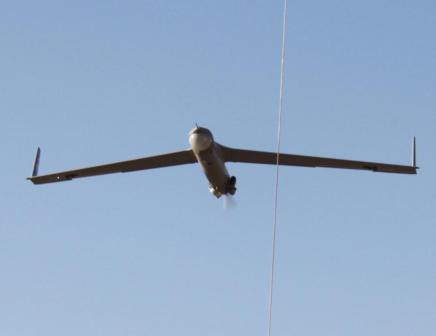
US to provide ScanEagle drones to Ukraine

Air Force secretary tight-lipped about new Phoenix Ghost suicide drone

Pentagon shares new vision to address problems with its microelectronics supply chain
American kamikazes: pentagon has big plans for suicide drones, marine corps commandant gung-ho about loitering munitions, white house wants $550m for new critical munitions acquisition fund, biden sending new drones to ukraine, latest podcasts.

How NASA is embracing AI to advance mission-critical efforts

Former U.S. Deputy CTO Nick Sinai joins the podcast

Nutanix’s Jason Langone on the best way to get an easy win with AI
- Veterans Affairs’ IT budget sparks bipartisan concern for modernization and development
- NIST issues final guidance update for protecting sensitive information
- USDS impact report showcases ‘a year of launching things’
- GSA appoints new members to FedRAMP advisory committee
- How 5G and mobile computing-at-the-edge are revolutionizing DOD’s future
- The power of the cloud to aid service members in their transition to civilian life
- Why ICAM at the edge is critical to enabling mission success
- Federal judge declines to grant DOJ interim injunction in Booz Allen antitrust case
- Federal cyber leaders proceed with caution on AI as a defensive tool
- Department of Education begins market research for cloud capabilities
- NASA balks on timeline to incorporate cyber into spacecraft acquisition policies
- A major USAID contractor said it was hacked in 2021. It’s still not sharing details
FedScoop TV
- Energy Department has cyber threats to infrastructure in mind with $70 million funding offer
- How NIWC Atlantic is approaching zero trust and trusted user policies

Today, the United States Air Force is retiring the Predator—a military unmanned aerial vehicle that was used in attacks against al Qaeda during the war on terrorism. The Museum’s Predator, on display at our building in Washington, DC, was one of the first three UAVs to fly operational missions over Afghanistan after September 11 th . Here, we take a look at the history and impact of the Predator on military aerial combat.
As an aerospace milestone, the Predator marked several significant transformations underway at the beginning of the 21st century, primarily the dramatic shift from so-called “manned” to Remotely Piloted Aircraft Systems (RPAS). This shift had occurred slowly, as cruise missiles, target drones, and autopilots narrowed the roles for onboard human pilots. In most RPAS, including the Predator, humans are essential to their routine operation. While no one flies on the Predator, and it often cruises under control of an autopilot, most of its functions occur at the hands of a pilot, sensor operator, and mission intelligence coordinator in the ground-control station. In this way, the Predator is more “manned” than many other combat aircraft.
The Development of the Predator
The Predator had an unconventional and rapid development cycle unusual in modern American military aircraft, with origins going back to a garage project by Israeli emigrant Abraham Karem. By 1983, he had developed a small long-endurance tactical reconnaissance UAV prototype called the Albatross for the Defense Advanced Research Projects Agency (DARPA). Five years later, further development had resulted in a more advanced design, the Amber, which was followed by the GNAT 750, a production-worthy design. Karem’s company and the GNAT 750 were soon acquired by General Atomics.
The Central Intelligence Agency (CIA) operated the GNAT 750 in operations over Bosnia and Herzegovina in 1993 and 1994. The program suffered from several technical issues, but it held enough promise that the Department of Defense expressed interest in a larger, more capable enhanced version of the GNAT 750 for medium-altitude tactical reconnaissance, soon designated RQ-1 Predator. By 1995, it too was operating over Bosnia and Herzegovina.
The National Air and Space Museum acquired Predator number 3034 in 2004 on the basis of its pivotal role in introducing armed RPAS into combat.
The Air Force soon saw the Predator as an interim replacement for a shortfall in tactical reconnaissance aircraft with the added benefit of a live satellite video link. Authority for Predator development came under the 645th Aeronautical Systems Group, nicknamed “Big Safari,” which had responsibility for rapid development of reconnaissance systems outside conventional “mil-spec” airworthiness standards, resulting in a capable, but fragile, aircraft. In the late 1990s, Big Safari expanded the Predator’s capability to include a laser designator to illuminate targets and guide weapons dropped from other aircraft. In 1999, this system had its first significant test during Operation Allied Force in Kosovo.
By 2000, concern over the rising threat of the al Qaeda terrorist organization and its leader, Osama bin Laden, encouraged Big Safari to accelerate the schedule for arming the Predator with the AGM-114 Hellfire laser-guided missile, originally developed for antitank helicopters. While Big Safari continued development in the United States, it also secretly operated several Predators from a base in Uzbekistan with the CIA during the summer and fall of 2000 to locate Osama bin Laden in Afghanistan.
Continuing concerns over the legality of targeting an individual like bin Laden with the armed Predator delayed further deployments to Uzbekistan through the summer of 2001. On September 11, just as Predator number 3034 was undergoing final trials before deployment, the worst-case al Qaeda attacks occurred in New York and Washington, D.C.
Predator number 3034 flew 164 operational missions over Afghanistan between September 2001 and January 2003. Between August and November 2002, during the middle of its operations from Uzbekistan, number 3034 undertook a detached deployment to another operational site where it flew 32 missions. The National Air and Space Museum acquired Predator number 3034 in 2004 on the basis of its pivotal role in introducing armed RPAS into combat.
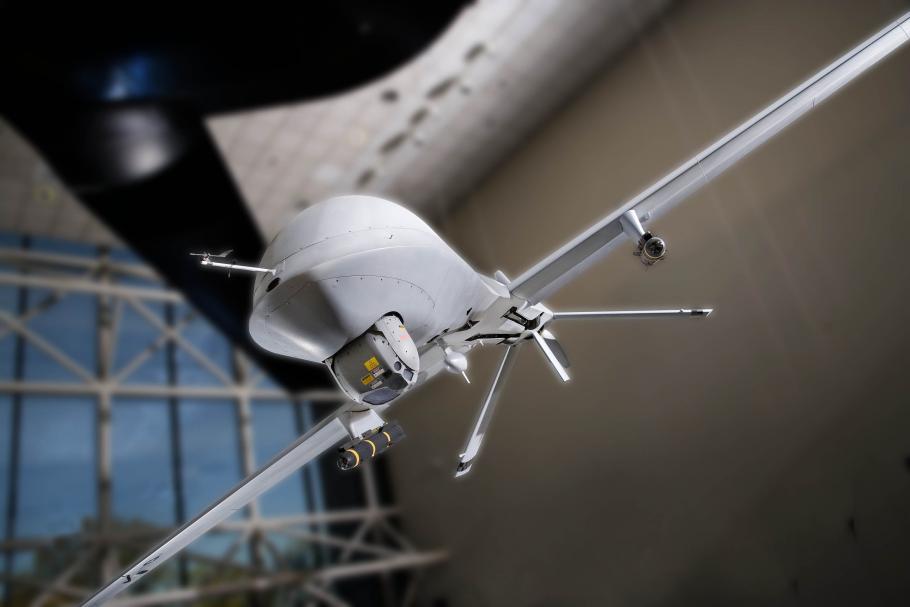
General Atomics Aeronautical Systems, Inc. MQ-1L Predator A: The Predator is capable of both reconnaissance and attack missions. It has been used in the Balkans, Afghanistan, Iraq and other global locations. The U.S. Air Force Predator displayed flew 196 combat missions in the skies of Afghanistan and was one of the first three UAVs to fly operational missions there after the 9/11 terrorist attacks. The Predator is currently on display at the National Air and Space Museum.
The Predator’s Impact
Given the small number of strikes made by Predators compared to manned aircraft, the impact was enormous. Its success in locating top enemy leaders made it a favorite tool of national security advisors and military commanders alike. In April 2001, the U.S. military had only 90 non–target drone UAVs in service, 75 of which were small battlefield observation types: the RQ-2 Pioneer and the RQ-7 Shadow. The other 15 were Predators. Four years later, the number had tripled. Ten years after that, the U.S. military had nearly 11,000 UAVs on inventory. The Predator alone does not account for this increase, but it unquestionably established the potential of the UAV to shape the battlefield and geopolitics in ways that no aircraft, manned or unmanned, had done before.
Previously, military strikes consisted of fast jet pilots arriving over a chaotic scene with little time to understand the situation, releasing heavy ordnance, and then quickly departing. Accuracy in such engagements could be problematic, particularly with terrorists or insurgents who blended with the local populace. Instead, with the ability to remain airborne for up to 40 hours (though operational missions rarely go much beyond 20), Predator pilots and sensor operators could understand the ground situation far more clearly than in any previous aerial platform. The Hellfire missile, while powerful, also has a narrow blast effect, which made possible precision strikes that were impossible from manned aircraft. At a typical operating altitude of 15,000 feet above the terrain, the Predator was silent and invisible to those on the ground (though not stealthy to radar).
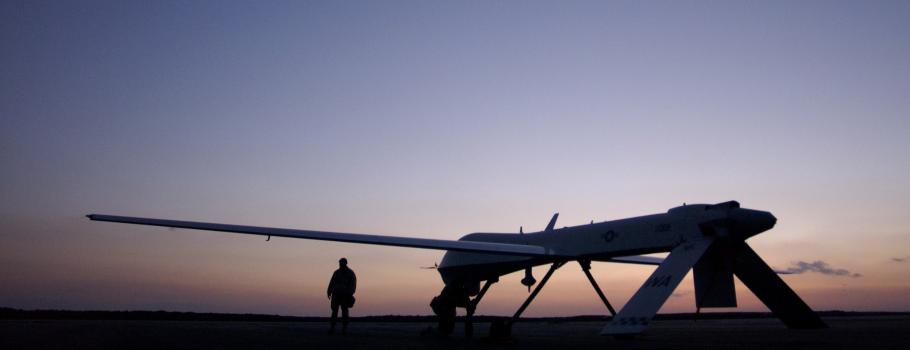
This new mode of warfare came with new problems. Because the Predator bypassed the normal procurement process and did not have to meet conventional military standards for ruggedness and reliability, it entered operations in something akin to a prototype phase of development. One concern was the “soda straw” effect of viewing the world through the tight focus of the camera lens and thus missing important nearby activity. This pushed investments in multiple camera array sensor systems that could monitor larger areas and use computer algorithms to highlight likely areas of concern, such as a vehicle driving in a certain manner or in the appearance of weapon system.
U.S. Air Force Predator production ended in 2011 with 268 airframes completed. Additional unarmed airframes were made available to U.S. allies, including the United Kingdom and Italy. The Army began development of a refined derivative, the MQ-1C Gray Eagle, which began operations in 2012. Even by the time of Operation Allied Force in 1999, the Air Force was aware that it needed a more capable and refined version of the Predator, so General Atomics began work on the “Predator B,” which entered operations in 2007 as the MQ-9 Reaper and slowly began replacing the Predator.
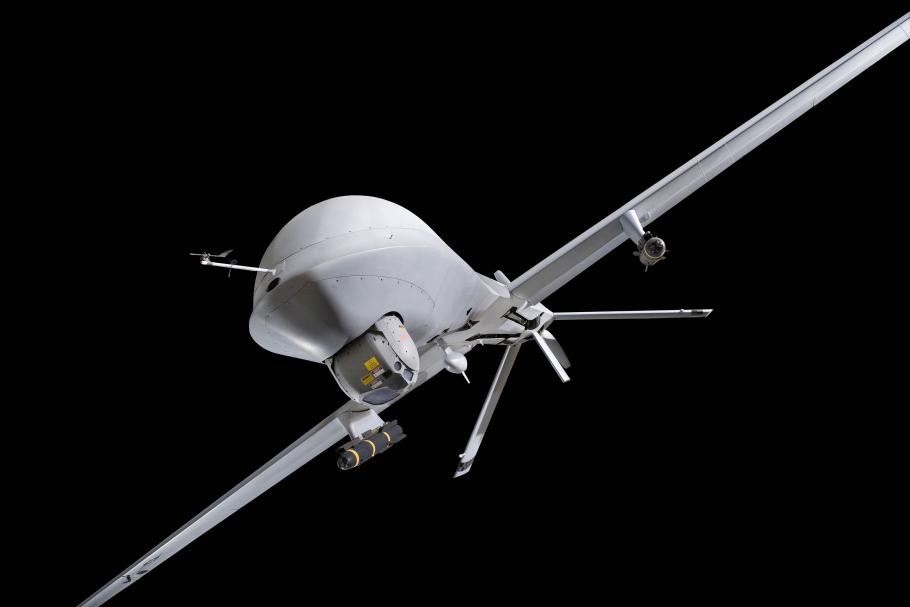
The Reaper and Predator are well-matched to the nature of the Global War on Terror. For the most part, they have operated against terrorists and insurgents who lack aircraft and air defenses. However, as operations in Iraq, Syria, and Kosovo have shown, they are extremely vulnerable when opposed by a capable enemy, as they are slow and cannot maneuver aggressively. In 2002, the Air Force even adapted a Predator to carry Stinger missiles and attempted an air-to-air engagement with an Iraqi MiG-25—a dogfight that resulted in the loss of the Predator.
The inability of Predator and Reaper to operate in contested airspace with effective enemy air defenses highlights the advances required for RPAS to maintain their operational significance. Jamming poses a significant threat to the Predator’s data links and GPS navigation, so future systems require significant advances in artificial intelligence and inertial navigation as well as faster and stealthier airframes. Another challenge is cultural—who is a pilot? Initially, most RPAS pilots for the U.S. Air Force were experienced combat pilots, but demand soon exceeded supply and the military services began training non-pilot operators. This has created organizational frictions in the military over who has the privileges of pilot status in a world where unmanned and autonomous operations are increasingly important. Regardless, the Predator and subsequent RPAS have dramatically changed the strategy and tactics of limited war in the 21st century.
We rely on the generous support of donors, sponsors, members, and other benefactors to share the history and impact of aviation and spaceflight, educate the public, and inspire future generations. With your help, we can continue to preserve and safeguard the world’s most comprehensive collection of artifacts representing the great achievements of flight and space exploration.
- Get Involved
- Host an Event
Thank you. You have successfully signed up for our newsletter.
Error message, sorry, there was a problem. please ensure your details are valid and try again..
- Free Timed-Entry Passes Required
- Terms of Use
Switch language:

USAF 55th Wing at Offutt AFB receives first WC-135R Constant Phoenix
The new WC-135R will serve as the USAF’s atmospheric collection aircraft.
- Share on Linkedin
- Share on Facebook
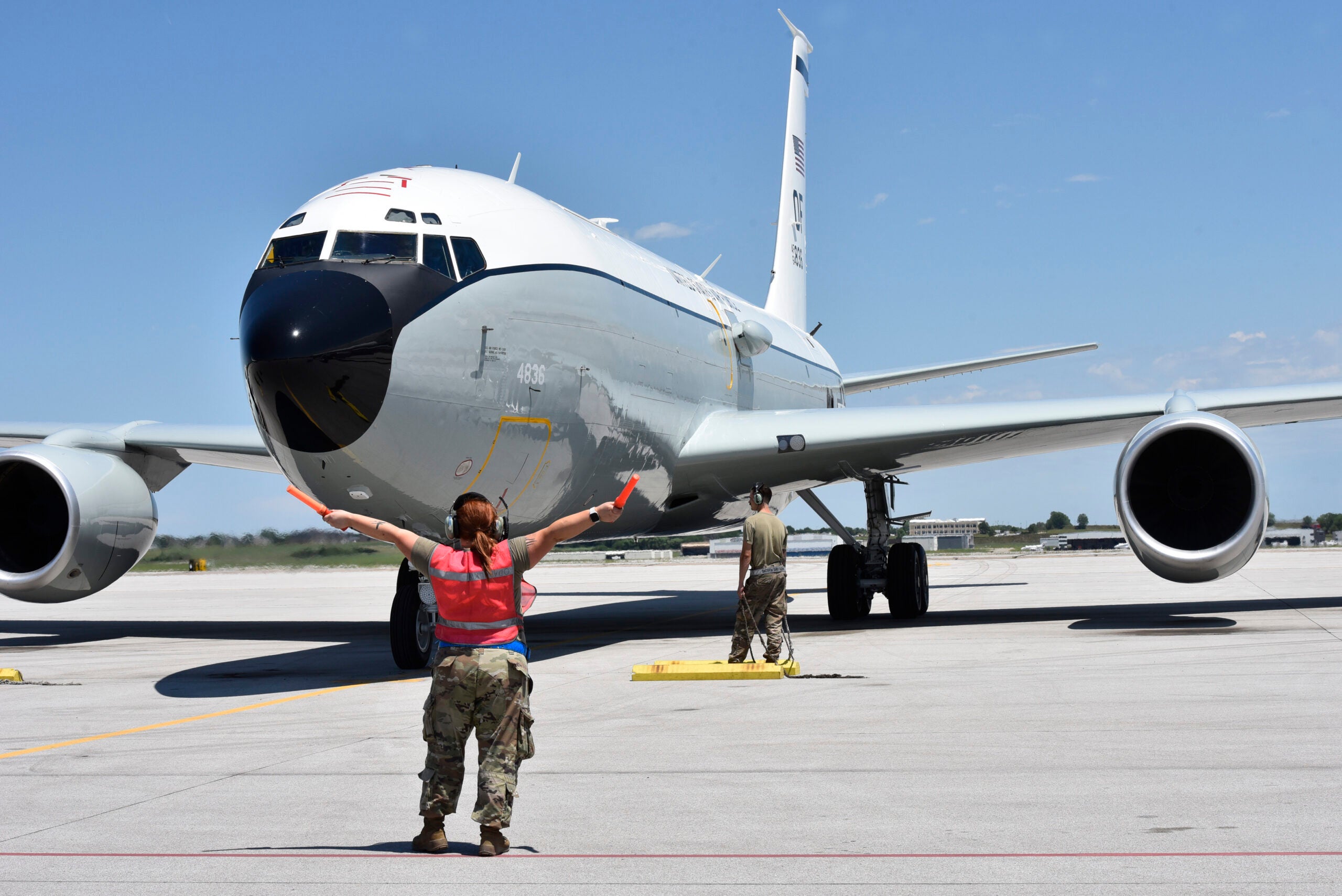
The US Air Force’s (USAF) 55th Wing at Offutt Air Force Base (AFB) has received its first of three WC-135R Constant Phoenix aircraft.
The aircraft, with tail number 64-14836, arrived at Lincoln Airport, Nebraska on 11 July. It will be fielded as the USAF’s atmospheric collection aircraft.
Go deeper with GlobalData


Manned-Unmanned Teaming (MUM-T) - Thematic Intelligence
Military fixed wing aircraft market size and trend analysis by segm..., premium insights.
The gold standard of business intelligence.
Find out more
Related Company Profiles
United states air force.
The latest delivery is part of the USAF’s programme to modify KC-135R Stratotankers to replace the legacy WC-135C/W fleet.
The modification of WC-135R was carried out by 645th Aeronautical Systems Group, also called Big Safari in Greenville, Texas.
The new aircraft is equipped with a new cockpit and same four high-bypass turbofan engines.
45th Reconnaissance Squadron (RS) commander lieutenant colonel Chris Crouch said: “When you add power of those engines and lower weight of this jet, you have an aircraft that is much more fuel efficient.
How well do you really know your competitors?
Access the most comprehensive Company Profiles on the market, powered by GlobalData. Save hours of research. Gain competitive edge.

Your download email will arrive shortly
Not ready to buy yet? Download a free sample
We are confident about the unique quality of our Company Profiles. However, we want you to make the most beneficial decision for your business, so we offer a free sample that you can download by submitting the below form
“We will have a lot more range to get to op areas that we could never reach before.”
The WC-135R will be operated and maintained by 45th RS, to support 21st Surveillance Squadron (SURS), Detachment 1 (Det 1) global missions.
21st SURS Det 1’s mission is to collect particulates, gaseous effluents and debris from accessible regions of atmosphere under the Limited Nuclear Test Ban Treaty of 1963.
Det 1 commander lieutenant colonel Sean Orme said: “The delivery of new aircraft ensures we keep pace with nuclear monitoring capabilities to continually reassure our allies.”
“The third aircraft will be pivotal in enhancing WC-135 ops flexibility, reliability, endurance, scientific analysis capacity and ensure crews are better ready to go into action at a moment’s notice.”
Delivery of second WC-135R is expected to take place in winter this year, followed by the third aircraft’s delivery scheduled in summer 2023.
Sign up for our daily news round-up!
Give your business an edge with our leading industry insights.
More Relevant
France orders first tranche of Arquus transport trucks
Uk conducts first flight using quantum navigation technology, sign up to the newsletter: in brief, your corporate email address, i would also like to subscribe to:.
Global Defence Technology : Airforce Technology Focus (monthly)
Thematic Take (monthly)
I consent to Verdict Media Limited collecting my details provided via this form in accordance with Privacy Policy
Thank you for subscribing
View all newsletters from across the GlobalData Media network.
- National Security
- Environment
- Special Investigations
- More Ways to Donate
- Impact & Reports
- Join Newsletter
- Become a Source
© THE INTERCEPT
ALL RIGHTS RESERVED
An Air Force Special Operations Surveillance Plane Is Lurking Near Portland During Federal Crackdown
An Air Force surveillance plane designed to carry state-of-the-art sensors typically reserved for war zones has been circling above Portland.
- Share on Facebook
- Share on LinkedIn
- Share on WhatsApp
While anonymous federal agents have thrown protesters into unmarked vans and fired tear gas at Portland’s mayor in recent days, an Air Force surveillance plane designed to carry state-of-the-art sensors typically reserved for war zones has circled the Oregon city’s outskirts from above.
The plane, a DO-328 “Cougar,” was spotted via the open source flight tracking website ADS-B Exchange, allowing the public to monitor its course. The Intercept reviewed this flight data , confirming tight, circular flights consistent with surveillance operations in and around Portland.
The aircraft is a twin-engine plane built in a modular fashion that allows it to be outfitted with long-range surveillance equipment suitable for supporting U.S. Special Operations commandos on the ground, according to Air Force documentation and previous public reporting . It was in Colorado earlier this month, looping over Denver and Boulder, before flying to Portland on July 19, and has been circling above Portland and its suburbs since July 21, according to publicly available flight data aggregated by websites like ADS-B Exchange .
At a Special Operations Forces Industry Conference in 2015, as first reported by the defense blog War Is Boring, Air Force Col. Eric Forsyth detailed the Cougar’s capabilities for conducting intelligence, surveillance, and reconnaissance, or ISR, showing off the equipment’s potential to aid U.S. troops from above. “With jacks for power, Ethernet, GPS and other linkages, engineers can easily install all sorts of gear,” wrote War Is Boring’s Joseph Trevithick at the time. “These systems would potentially be able to run long-range radars, powerful cameras, high-powered radios, laser range finders and more.”

DO-328 “Cougar” capabilities as presented at a May 2015 Special Operations Forces Industry Conference.
The Cougar that has been orbiting Portland is registered to the 645th Aeronautical Engineering Group at Wright-Patterson Air Force Base in Ohio, quite a distance from Portland. The 645th previously operated under the code name “BIG SAFARI,” and was founded in 1952 to centralize the Air Force’s covert surveillance programs during the Cold War. “BIG SAFARI has long been an alternative acquisition source for certain high priority, rapid-reaction, urgent Combatant Commander needs,” former Air Force Secretary Michael Donley said in a 2010 address. A 2018 obit for former BIG SAFARI director Bill Grimes described the entity as “a secretive Air Force acquisition program for specialized special mission aircraft.”
While the Cougar’s impressive potential for wide-area wartime surveillance is clear, it’s less obvious why a warplane is flying tight circles — typically a dead giveaway of aerial surveillance — near domestic protests, or on whose orders. Last month, Motherboard reported similar surveillance flyovers by the National Guard over protests. It’s unclear whether the Air Force is engaging in active surveillance of the protesters or merely testing the plane’s capabilities to do so or doing something entirely unrelated.
The Air Force did not respond to The Intercept’s request for comment. Sen. Ron Wyden, D-Ore., a Portland resident who was made aware of the flights by The Intercept’s inquiry to his office, made his own request to the Air Force for information. In a response to Wyden made after this story was initially published, the Air Force denied the flights were surveilling protesters. “This week the Air Force conducted previously planned test flights in the Northwest United States that required the environmental conditions typical of the region. This location was chosen several months ago due to the high likelihood of cloud cover desired for this equipment test,” the Air Force wrote to Wyden. “The Dornier 328 aircraft, assigned to Air Force Materiel Command’s 645th Aeronautical Engineering Group, was not gathering intelligence or conducting operations related to civil unrest in Portland, Oregon.” (According to flight tracking data, the surveillance plane left the Portland area early Friday morning.)
Wyden told The Intercept the Air Force’s response raised its own questions. “The Air Force should know better than to fly circles over American cities when armed federal troops are beating and gassing protesters below,” he said. “Even if this was a test flight arranged months ago, the Air Force’s decision to continue as planned, rather than delaying the flight, raises serious questions about the judgement of the military leaders who approved the flight.” (Wyden, who said would be “totally unacceptable” for the military to surveil protests in the U.S., initially told The Intercept that, in addition to an explanation, he has asked the Air Force “what data it is collecting and who approved the mission” — questions that remain unanswered.)
Other members of Congress were skeptical of the Air Force’s explanation. “Too much coincidence to be credible,” tweeted Sen. Richard Blumenthal, D-Conn, who suggested there should be Inspector General and Congressional investigations. “More than an IG investigation, it’s time now for the Senate Armed Services Committee to show strength & apply scrutiny. Hold hearings & investigate Trump’s misuse of military against Americans.”
Experts had raised questions about the test flights even before the Air Force made its claims.
“Big Safari is all about testing new equipment, so maybe we are seeing the next generation of spy tech being used domestically right now, or they are taking advantage of the situation to improve testing,” independent investigative journalist and plane-tracking enthusiast Sam Richards, who has been monitoring the flights, told The Intercept. “I think it is naive to not take these flights seriously given the way this administration is cracking down on these uprisings.”
The flights don’t seem to have taken place directly over downtown Portland, the epicenter of the protests, but rather at a range of 20 to 30 miles from the city’s center. That could still allow for fine-grained surveillance, however; a 2016 Bloomberg report on police aerial surveillance over Baltimore noted the small civilian planes used there could surveil an area of up to 30 square miles.

Flight data from a recent DO-328 “Cougar” mission just outside Portland.
The mere presence near Portland of a plane designed to stress test SOCOM’s aerial spy gear is enough to concern some observers. “The apparent use of military aircraft in a domestic operation should set off all kinds of alarm bells,” said Steven Aftergood, director of the Federation of American Scientists’ Government Secrecy Project. “What is their mission? Under what authority are they operating, and who authorized them? It seems like the administration is pushing right through what had been established norms of transparency and accountability.”
The vast array of power surveillance gear this plane potentially could be carrying on these flights is cause for concerns over privacy and political expression. “These aircraft are believed to carry SIGINT [signals intelligence] sensors; if that is the case, then circling at that distance would probably (depending on the altitude) allow the sensors to collect data,” David Cenciotti, a retired Italian Air Force officer and aerospace journalist, told The Intercept, though he noted that he could only speculate without knowing the Cougar’s actual payload.
Update: July 25, 2020 This article has been updated to include responses made after publication by the Air Force to the office of Sen. Ron Wyden’s inquiries, Wyden’s reaction, a reaction from Sen. Richard Blumenthal, and information about when the Air Force plane left the Portland area.
Contact the author:
Additional credits:.
Additional Reporting: Matthew Cole

As Trump Threatens Secret Police Deployment Nationwide, Democrats Debate Expanding Surveillance Powers and New Money for DHS

Leaked Documents Show Police Knew Far-Right Extremists Were the Real Threat at Protests, Not “Antifa”

Lawsuit Aims to Stop Baltimore Police From Using War-Zone Surveillance System to Spy on Residents

A Secret Catalogue of Government Gear for Spying on Your Cellphone
Latest stories.

Israel’s War on Gaza
The State Department Says Israel Isn’t Blocking Aid. Videos Show the Opposite.
Prem Thakker
From targeting humanitarian vehicles to standing by as mobs attack trucks, Israel is blocking aid from reaching Gaza.

Medical Workers Evacuated From Gaza, but 3 Americans Refuse to Leave
Ryan Grim, Jeremy Scahill
Remaining health care workers won’t go until Israel stops blocking entry of new medical personnel.

An Israeli Company Is Hawking Its Self-Launching Drone System to U.S. Police Departments
Delaney Nolan
A Louisiana sheriff’s department has been testing the drone system, which is already used by the Israeli police and many settlements.
Are you an EPFL student looking for a semester project?
Work with us on data science and visualisation projects , and deploy your project as an app on top of GraphSearch.
Learn more about Graph Apps .
645th Aeronautical Systems Group
- https://en.wikipedia.org/wiki/645th_Aeronautical_Systems_Group
Copyright © 2024 EPFL, all rights reserved
- USAF's Big Safari Program receives TC-135W, prepares to divest last NC-135W

On February 14, a USAF -operated Boeing TC-135W (serial 62-4133) departed Offutt Air Force Base (AFB) , Nebraska, for Greenville-Majors Airport, Texas, where it will be reassigned to the air arm’s Big Safari Program and redesignated as an NC-135 platform.
The aircraft was flown to Texas by members of the 238th Combat Training Squadron under the callsign ‘Windsor 01’ and will ultimately become responsible for the testing of surveillance equipment modifications which, if successful, will be added to the USAF’s core fleet of RC-135S/U/V/W reconnaissance aircraft. This is not the first time that 62-4133 has been operated in the test role since it completed its maiden flight in July 1962. In 1967, the aircraft was redesignated as an EC-135B when it received a 10ft nose extension and was fitted with equipment from the EC-135N Apollo Range Instrument Aircraft (ARIA).

It was then converted into a TC-135S in 1985 and served as a training aircraft for the RC-135S Cobra Ball fleet. At the time, these aircraft did not have the ‘chipmunk cheeks’ fitted to the forward fuselage that is a synonymous feature of the RC-135 fleet today. Until now, the aircraft had served as part of the 45th Reconnaissance Squadron in this same role.
Having been delivered for its new assignment, 62-4133 will now take over the Big Safari test role from NC-135W (serial 61-2666), which has been responsible for testing equipment for the core RC-135 fleet since the mid-1990s. This aircraft – which is the sole remaining C-135 in the USAF inventory that is equipped with Pratt & Whitney TF-33 turbofan engines – will be retired from use once 62-4133 becomes fully available.
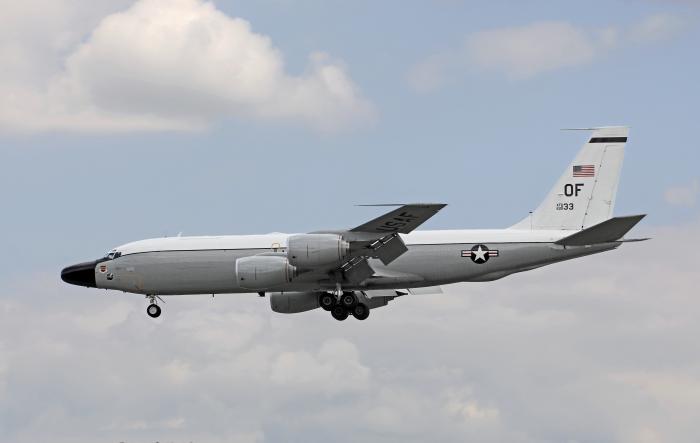
Its retirement follows a series of divestments of a similar nature, including the two OC-135B Open Skies aircraft and the WC-135C/W Constant Phoenix fleet, which was used for atmospheric testing and collection purposes. As these aircraft have aged, parts have become less available and the airframes have grown more difficult to maintain. The introduction of 62-4133 as the new NC-135 test aircraft will bring the Big Safari Program in line with the remainder of the fleet.
Two training-configured TC-135Ws (serials 62-4127 and 62-4129) still remain assigned to the 55th Wing at Offutt. In 2019, 62-4127 became the first aircraft to have ‘Baseline Charlie’ installed, which was the fleet-wide glass cockpit modification. This was the first real sign of alternatives to 61-2666 being used to test RC-135 fleet modifications
- United States (US)
- US Air Force (USAF)
- Flight Testing
- Boeing RC-135 Rivet Joint
- Boeing TC-135
- Boeing NC-135

Originally published in Key.Aero
Become a premium member.
Subscribe to Key.Aero now to enjoy great benefits:
- Access a wealth of aviation content in one place
- Support world-class journalism
- Join a community of passionate aviation enthusiasts
- All completely ad free!
Subscribe to Key.Aero now
Related articles
- Still Going Strong - Special Mission Aircraft
- USAF retires final ‘Big Safari’ NC-135W to the Boneyard
- USAF, RAF crews conduct joint RC-135 training at Red Flag 23-1
- Third RAF Rivet Joint arrives in UK
Get the Key.Aero newsletter
Receive exclusive content, offers, competitions and more.

LMAG - Big Safari - US Air Force Fast Intervention Program
Big Safari: US Air Force Fast Intervention Program
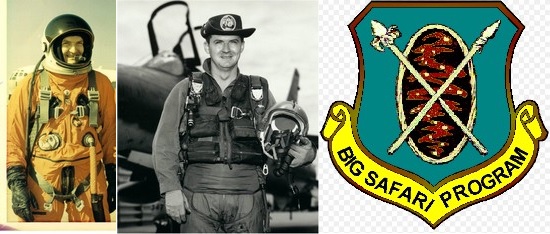
New Location this Month: CLU Overton Hall ( map )
Abstract For more than 50 years, Big Safari aircraft have performed dangerous and essential missions to collect intelligence, conduct surveillance and reconnaissance, and engage in special operations missions around the globe in the interest of national security. Big Safari represents a system designed for fast intervention that focuses on providing quick access to resources, efficient contracting engagements with suppliers and streamlined processes and distribution methods. Key personnel are trained for most efficient interventions. Jerry Knotts served 24 years in the US Air Force (USAF) and was a team member of the USAF Big Safari Program.
About the Speaker Colonel Jerry E. Knotts (Ret.) was fourteen years in the Big Safari special reconnaissance program at General Dynamics in Fort Worth, Texas; E-Systems in Greenville, Texas; and Lockheed Aircraft Services in Ontario, California. Jerry was responsible for creating and flight testing a number of specially configured aircraft, including the Combat Sent, Combat Talon, Cobra Ball, Rivet Joint and many others. During 1968, he completed 112 missions over North Vietnam in an F-105 Wild Weasel.
Jerry retired from the Air Force with 24 years of service. His last assignment was as commander of the Washington Area Contracting Center at Andrews Air Force Base. He was responsible for Air Force procurement throughout the Nation's Capital, and a region from the Azores to Saint Louis, His responsibilities included the White House and the Presidential VIP aircraft fleet that included the aircraft now in the Ronald Reagan Presidential Library Hanger.
For his outstanding service to our nation, Jerry received the Legion of Merit, Distinguished Flying Cross, Meritorious Service Medal with two oak leaf clusters, Air Medal with 13 oak leaf clusters, and the Air Force Commendation Medal.
For his remarkable public service, Jerry has received numerous awards. In 1996 he was honored by the Conejo Valley Historical Society. That same year, Jerry and his wife, Mary, both received the William E. Hamm Award from the California Lutheran University Community Leaders Club. Jerry also has been honored for his community service by having a seat designated in his name in the Thousand Oaks Civic Center Forum Theater. He previously received the Outstanding Service Award and the Silver Patrick Henry Medal from the Military Order of the World Wars.
Since retirement from the USAF, Jerry Knotts has been a serial entrepreneur, coach, angel investor and has worked with numerous entrepreneurs for over 30 years. Over this period of time, he started five companies and mentored over 400 start-ups.
Currently, Jerry is President, California Coast Venture Forum, Inc.( www.ccvf.org ), parent of the Clean Business Investment Summit and Chairman, Entrepreneurs Without Borders. He serves as mentor/screener for SoCalBio and the LARTA Institute wherein he supports DARPA, NSF, and the NIH-CAP (National Institute of Health - Commercialization Assistance Program). As treasurer, Youth Enrichment Foundation, Alexandria, VA, he supports 28 Youth Leadership Conferences throughout the country. He is also Executive Secretary, Society of Wild Weasels and board member/Treasurer of the Air Warrior Courage Foundation (AWCF) / Wounded Warriors Emergency Support Fund that supports wounded warriors in areas not covered by government programs.
He is a member, Dean's Board of Advisors, California Lutheran University (CLU) School of Management, a mentor with CLU, UCLA, UCSF, Auburn, Penn State, CSUCI and UCSB Entrepreneur programs and a panel member for the Goldman Sachs 10,000 Businesses Program at LACC and LBCC. His previous executive positions included Vice-President/General Manager, Government Electronics Division, California Microwave Inc. (CMI), Woodland Hills, CA; and Vice-President, American Nucleonics Corporation (ANC), Westlake Village, CA. These two companies provided specialized airborne electronic reconnaissance systems.
Jerry holds a BSEE (Electrical Engineering) from The Pennsylvania State University; and an MBA from Auburn University. In addition, he is a graduate of the Defense Acquisition University, Industrial College of the Armed Forces, Air Command and Staff College, and Air War College. He is a Senior Life Member of the Institute of Electrical and Electronic Engineers (IEEE); Chairman, IEEE Buenaventura Life Member Affinity Group, and past Secretary, IEEE Buenaventura Section. Jerry is a pilot, licensed Registered Professional Engineer (PE), Amateur Radio operator (K3ZZO) and life member of the Texas, California, and National Society of Professional Engineers. He is also a life member of both the Red River Valley Fighter Pilots Association (River Rats) and the Society of Wild Weasels.
Agenda Pizza and Networking: 6:30 PM Presentation: 7:00 PM
New Location CLU - Overton Hall California Lutheran University 3163 Regent Avenue Thousand Oaks, CA 91360 ( map )
Parking: Visitors may park on CLU streets after 7 PM without a permit. Before 7 PM, we recommend that you park in the G1 visitor lot on the southwest corner of Olsen and Mountclef, and walk to Overton Hall. Do not park in the faculty/staff/reserved lots.
Presented By: IEEE Buenaventura Aerospace and Electronic Systems Society Chapter
The Unique Burial of a Child of Early Scythian Time at the Cemetery of Saryg-Bulun (Tuva)
<< Previous page
Pages: 379-406
In 1988, the Tuvan Archaeological Expedition (led by M. E. Kilunovskaya and V. A. Semenov) discovered a unique burial of the early Iron Age at Saryg-Bulun in Central Tuva. There are two burial mounds of the Aldy-Bel culture dated by 7th century BC. Within the barrows, which adjoined one another, forming a figure-of-eight, there were discovered 7 burials, from which a representative collection of artifacts was recovered. Burial 5 was the most unique, it was found in a coffin made of a larch trunk, with a tightly closed lid. Due to the preservative properties of larch and lack of air access, the coffin contained a well-preserved mummy of a child with an accompanying set of grave goods. The interred individual retained the skin on his face and had a leather headdress painted with red pigment and a coat, sewn from jerboa fur. The coat was belted with a leather belt with bronze ornaments and buckles. Besides that, a leather quiver with arrows with the shafts decorated with painted ornaments, fully preserved battle pick and a bow were buried in the coffin. Unexpectedly, the full-genomic analysis, showed that the individual was female. This fact opens a new aspect in the study of the social history of the Scythian society and perhaps brings us back to the myth of the Amazons, discussed by Herodotus. Of course, this discovery is unique in its preservation for the Scythian culture of Tuva and requires careful study and conservation.
Keywords: Tuva, Early Iron Age, early Scythian period, Aldy-Bel culture, barrow, burial in the coffin, mummy, full genome sequencing, aDNA
Information about authors: Marina Kilunovskaya (Saint Petersburg, Russian Federation). Candidate of Historical Sciences. Institute for the History of Material Culture of the Russian Academy of Sciences. Dvortsovaya Emb., 18, Saint Petersburg, 191186, Russian Federation E-mail: [email protected] Vladimir Semenov (Saint Petersburg, Russian Federation). Candidate of Historical Sciences. Institute for the History of Material Culture of the Russian Academy of Sciences. Dvortsovaya Emb., 18, Saint Petersburg, 191186, Russian Federation E-mail: [email protected] Varvara Busova (Moscow, Russian Federation). (Saint Petersburg, Russian Federation). Institute for the History of Material Culture of the Russian Academy of Sciences. Dvortsovaya Emb., 18, Saint Petersburg, 191186, Russian Federation E-mail: [email protected] Kharis Mustafin (Moscow, Russian Federation). Candidate of Technical Sciences. Moscow Institute of Physics and Technology. Institutsky Lane, 9, Dolgoprudny, 141701, Moscow Oblast, Russian Federation E-mail: [email protected] Irina Alborova (Moscow, Russian Federation). Candidate of Biological Sciences. Moscow Institute of Physics and Technology. Institutsky Lane, 9, Dolgoprudny, 141701, Moscow Oblast, Russian Federation E-mail: [email protected] Alina Matzvai (Moscow, Russian Federation). Moscow Institute of Physics and Technology. Institutsky Lane, 9, Dolgoprudny, 141701, Moscow Oblast, Russian Federation E-mail: [email protected]
Shopping Cart Items: 0 Cart Total: 0,00 € place your order
Price pdf version
student - 2,75 € individual - 3,00 € institutional - 7,00 €

Copyright В© 1999-2022. Stratum Publishing House
- Yekaterinburg
- Novosibirsk
- Vladivostok

- Tours to Russia
- Practicalities
- Russia in Lists
Rusmania • Deep into Russia
Out of the Centre
Savvino-storozhevsky monastery and museum.

Zvenigorod's most famous sight is the Savvino-Storozhevsky Monastery, which was founded in 1398 by the monk Savva from the Troitse-Sergieva Lavra, at the invitation and with the support of Prince Yury Dmitrievich of Zvenigorod. Savva was later canonised as St Sabbas (Savva) of Storozhev. The monastery late flourished under the reign of Tsar Alexis, who chose the monastery as his family church and often went on pilgrimage there and made lots of donations to it. Most of the monastery’s buildings date from this time. The monastery is heavily fortified with thick walls and six towers, the most impressive of which is the Krasny Tower which also serves as the eastern entrance. The monastery was closed in 1918 and only reopened in 1995. In 1998 Patriarch Alexius II took part in a service to return the relics of St Sabbas to the monastery. Today the monastery has the status of a stauropegic monastery, which is second in status to a lavra. In addition to being a working monastery, it also holds the Zvenigorod Historical, Architectural and Art Museum.
Belfry and Neighbouring Churches

Located near the main entrance is the monastery's belfry which is perhaps the calling card of the monastery due to its uniqueness. It was built in the 1650s and the St Sergius of Radonezh’s Church was opened on the middle tier in the mid-17th century, although it was originally dedicated to the Trinity. The belfry's 35-tonne Great Bladgovestny Bell fell in 1941 and was only restored and returned in 2003. Attached to the belfry is a large refectory and the Transfiguration Church, both of which were built on the orders of Tsar Alexis in the 1650s.

To the left of the belfry is another, smaller, refectory which is attached to the Trinity Gate-Church, which was also constructed in the 1650s on the orders of Tsar Alexis who made it his own family church. The church is elaborately decorated with colourful trims and underneath the archway is a beautiful 19th century fresco.
Nativity of Virgin Mary Cathedral

The Nativity of Virgin Mary Cathedral is the oldest building in the monastery and among the oldest buildings in the Moscow Region. It was built between 1404 and 1405 during the lifetime of St Sabbas and using the funds of Prince Yury of Zvenigorod. The white-stone cathedral is a standard four-pillar design with a single golden dome. After the death of St Sabbas he was interred in the cathedral and a new altar dedicated to him was added.

Under the reign of Tsar Alexis the cathedral was decorated with frescoes by Stepan Ryazanets, some of which remain today. Tsar Alexis also presented the cathedral with a five-tier iconostasis, the top row of icons have been preserved.
Tsaritsa's Chambers

The Nativity of Virgin Mary Cathedral is located between the Tsaritsa's Chambers of the left and the Palace of Tsar Alexis on the right. The Tsaritsa's Chambers were built in the mid-17th century for the wife of Tsar Alexey - Tsaritsa Maria Ilinichna Miloskavskaya. The design of the building is influenced by the ancient Russian architectural style. Is prettier than the Tsar's chambers opposite, being red in colour with elaborately decorated window frames and entrance.

At present the Tsaritsa's Chambers houses the Zvenigorod Historical, Architectural and Art Museum. Among its displays is an accurate recreation of the interior of a noble lady's chambers including furniture, decorations and a decorated tiled oven, and an exhibition on the history of Zvenigorod and the monastery.
Palace of Tsar Alexis

The Palace of Tsar Alexis was built in the 1650s and is now one of the best surviving examples of non-religious architecture of that era. It was built especially for Tsar Alexis who often visited the monastery on religious pilgrimages. Its most striking feature is its pretty row of nine chimney spouts which resemble towers.

Plan your next trip to Russia
Ready-to-book tours.
Your holiday in Russia starts here. Choose and book your tour to Russia.
REQUEST A CUSTOMISED TRIP
Looking for something unique? Create the trip of your dreams with the help of our experts.
FAS | Intelligence | Programs | Collect |||| Index | Search |
Sources and methods.



IMAGES
VIDEO
COMMENTS
645th Aeronautical Systems Group. Big Safari is a United States Air Force program begun in 1952 which provides management, direction, and control of the acquisition, modification, and logistics support for special purpose weapons systems derived from existing aircraft and systems. To that end, the program operates under procurement procedures ...
In 1992, these 2 commands were once again recombined into the AMC. Big Safari was eventually reactivated in 2005 after a hiatus of unknown length, though it is likely that the program was inactive from the late 1970s till the late 1980s [source]. It was in 2005 that Big Safari explicitly became the 645th Aeronautical Systems Group.
The research-and-development effort for the weapon was overseen by the 645th Aeronautical Systems Group, also known as Big Safari, which works on special projects, Undersecretary of Defense for Acquisition and Sustainment William LaPlante told reporters at the Pentagon. The organization is based at Wright-Patterson Air Force Base, Ohio.
Authority for Predator development came under the 645th Aeronautical Systems Group, nicknamed "Big Safari," which had responsibility for rapid development of reconnaissance systems outside conventional "mil-spec" airworthiness standards, resulting in a capable, but fragile, aircraft. In the late 1990s, Big Safari expanded the Predator ...
Approved on 5 Oct 2021. Prepared by SrA Matthew H. Scales. Reviewed by Carl E. Bailey. Lineage. Constituted BIG SAFARI Systems Group on 23 Nov 2004. Activated on 18 Jan 2005. Redesignated 645 Aeronautical Systems Group on 14 Jul 2006. Assignments. Reconnaissance (later, 303 Aeronautical) Systems Wing, 18 Jan 2005-.
After being modified by the 645th Aeronautical Systems Group, also known as Big Safari, the aircraft arrives at Offutt with a brand-new cockpit and the same CFM-56 turbofan engines as the rest of the wing's 135 fleet. This casts a wider net for potential aircrew and eases some of the burden on maintenance personnel.
June 7, 2020 ·. A closer look at USAF's "Big Safari" small aircraft. They operate unseen almost every day. The smaller aircraft, managed by the 645th Aeronautical Systems Group, are among the most inconspicuous and rare ones in the USAF inventory. Headquartered at Wright Patterson AFB, next to Dayton (OH), the 645th Aeronautical Systems Group ...
The modification of WC-135R was carried out by 645th Aeronautical Systems Group, also called Big Safari in Greenville, Texas. The new aircraft is equipped with a new cockpit and same four high-bypass turbofan engines. See Also: Romania receives US approval for AIM-9X Sidewinder sale ;
July 23, 2022 ·. On Thursday, July 21, 2022, Col. Andrew Jutte became commander of the 645th. Aeronautical Systems Group, also known as Big Safari. He assumes the position from Col. Christopher Lohr. #AFLCMC commander, Lt. Gen. Shaun Q. Morris presided over the Change of Command ceremony. Big Safari is a #USAF acquisition program that ...
The 645th previously operated under the code name "BIG SAFARI," and was founded in 1952 to centralize the Air Force's covert surveillance programs during the Cold War.
This final Stratolifter had been operated by the 645th Aeronautical Systems Squadron, with the aircraft serving as a Big Safari testbed for the USAF's fleet of RC-135V/W Rivet Joint intelligence-gathering aircraft. This aircraft initially entered operational USAF service under the C-135B designation on March 30, 1962.
Col Mizell was the commander of the 645th Aeronautical Systems Squadron, Big Safari, served as a professor and the military fellow to the School of Foreign Service, Georgetown University, was the Joint Staff's liaison to the Defense Advanced Research Projects Agency (DARPA), and was the Chief of JOCE, the primary liaison between the Senior U ...
Big Safari is a United States Air Force program begun in 1952 which provides management, direction, and control of the acquisition, modification, and logistics support for special purpose weapons systems derived from existing aircraft and systems. To that end, the program operates under procurement procedures which allow it in most cases to designate the contractor.
News. On February 14, a USAF -operated Boeing TC-135W (serial 62-4133) departed Offutt Air Force Base (AFB), Nebraska, for Greenville-Majors Airport, Texas, where it will be reassigned to the air arm's Big Safari Program and redesignated as an NC-135 platform. The aircraft was flown to Texas by members of the 238th Combat Training Squadron ...
Big Safari: US Air Force Fast Intervention Program. New Location this Month: CLU Overton Hall (). Abstract For more than 50 years, Big Safari aircraft have performed dangerous and essential missions to collect intelligence, conduct surveillance and reconnaissance, and engage in special operations missions around the globe in the interest of national security.
University at Maxwell AFB, Ala. In "Predator's Big Safari," I have been able to add quite a few facts, details, and narrative context to what Sean wrote, but his "Weaponizing the Predator UAV: Toward a New Theory of Weapon System Innovation," remains a seminal and extremely valuable work on the subject. Richard Whittle July 2011
Moscow Oblast (Russian: Московская область, romanized: Moskovskaya oblast, IPA: [mɐˈskofskəjə ˈobləsʲtʲ], informally known as Подмосковье, Podmoskovye, IPA: [pədmɐˈskovʲjə]) is a federal subject of Russia (an oblast).With a population of 8,524,665 (2021 Census) living in an area of 44,300 square kilometers (17,100 sq mi), it is one of the most densely ...
Burial 5 was the most unique, it was found in a coffin made of a larch trunk, with a tightly closed lid. Due to the preservative properties of larch and lack of air access, the coffin contained a well-preserved mummy of a child with an accompanying set of grave goods. The interred individual retained the skin on his face and had a leather ...
Zvenigorod's most famous sight is the Savvino-Storozhevsky Monastery, which was founded in 1398 by the monk Savva from the Troitse-Sergieva Lavra, at the invitation and with the support of Prince Yury Dmitrievich of Zvenigorod. Savva was later canonised as St Sabbas (Savva) of Storozhev. The monastery late flourished under the reign of Tsar ...
Big Safari was also employed to support the 1994 reactivation of the SR-71, and it was the only AF office that tried to promote the program. The Lockheed Martin Skunk Works has been a primary contributor to Big Safari, transforming C-130s into Combat Talon (MC-130E), Compass Call/Rivet Fire (EC-130H), Commando Solo (EC-130E), AC-130H Gunship ...
Welcome to the 628DirtRooster website where you can find video links to Randy McCaffrey's (AKA DirtRooster) YouTube videos, community support and other resources for the Hobby Beekeepers and the official 628DirtRooster online store where you can find 628DirtRooster hats and shirts, local Mississippi honey and whole lot more!